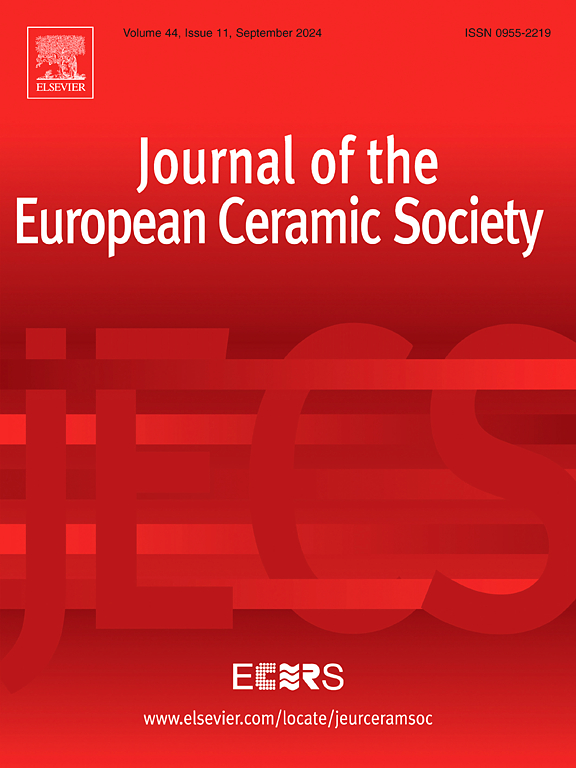Significantly enhanced energy storage performance achieved by relaxor-antiferroelectricity in silver sodium niobate ceramics
IF 5.8
2区 材料科学
Q1 MATERIALS SCIENCE, CERAMICS
Journal of The European Ceramic Society
Pub Date : 2025-04-25
DOI:10.1016/j.jeurceramsoc.2025.117481
引用次数: 0
Abstract
AgNbO3 antiferroelectric materials have garnered significant research interest for applications in high-power energy-storage systems. However, the high manufacturing cost due to expensive “Ag” restricts their commercial applications. Herein, we studied an antiferroelectric ceramic system at a lower cost:(Ag0.5–3xSmxNa0.5)NbO3(ASNNx). The results show that at x ≤ 0.05, the “chemical-pressure” provided by Sm-doping compresses antiferroelectric unit-cell and suppresses spontaneous polarization, boosting antiferroelectric stability. At x = 0.07, the antiferroelectric Pbcm phase evolves into a paraelectric P4/mbm phase displaying classic dielectric relaxation characteristic. Analysis of both composition- and temperature-driven electrical polarization behavior indicates the presence of numerous antipolar clusters (i.e., relaxor-antiferroelectric state) in the P4/mbm lattice, resulting in significantly enhanced energy-storage performance (Wrec = 3.9 J/cm3, η = 83 %) compared to the initial composition, with a temperature variation rate ≤ 3 % over 30–140 °C. Pulsed discharge results for ASNN0.07 ceramic show that at E = 250 kV/cm, the Wdis= 2.6 J/cm³ , PD = 140 MW/cm³ and t0.9 = 50 ns, rivaling previously reported (Ag,Sm)NbO3 ceramics; in particular, it only contains 29 % Ag.
弛豫-反铁电在铌酸银钠陶瓷中实现了显著增强的储能性能
AgNbO3反铁电材料在大功率储能系统中的应用获得了重要的研究兴趣。然而,由于“银”的昂贵,制造成本高,限制了它们的商业应用。本文研究了一种成本较低的反铁电陶瓷体系:(Ag0.5-3xSmxNa0.5)NbO3(ASNNx)。结果表明,在x ≤ 0.05时,sm掺杂提供的“化学压力”压缩了反铁电单胞,抑制了自发极化,提高了反铁电稳定性。在x = 0.07处,反铁电Pbcm相演化为具有典型介电弛豫特性的准电P4/mbm相。对成分和温度驱动的电极化行为的分析表明,P4/mbm晶格中存在大量反极性团簇(即弛豫-反铁电态),与初始成分相比,储能性能显著增强(Wrec = 3.9 J/cm3, η = 83 %),在30-140 °C范围内,温度变化率≤ 3 %。脉冲放电ASNN0.07陶瓷的结果表明E = 250 kV / cm,编写《= 2.6 J / cm³ ,PD = 140 MW /厘米³ t0.9 = 50 ns,堪比之前报道(Ag)、Sm) NbO3陶瓷;特别是,它只含有29 % Ag。
本文章由计算机程序翻译,如有差异,请以英文原文为准。
求助全文
约1分钟内获得全文
求助全文
来源期刊

Journal of The European Ceramic Society
工程技术-材料科学:硅酸盐
CiteScore
10.70
自引率
12.30%
发文量
863
审稿时长
35 days
期刊介绍:
The Journal of the European Ceramic Society publishes the results of original research and reviews relating to ceramic materials. Papers of either an experimental or theoretical character will be welcomed on a fully international basis. The emphasis is on novel generic science concerning the relationships between processing, microstructure and properties of polycrystalline ceramics consolidated at high temperature. Papers may relate to any of the conventional categories of ceramic: structural, functional, traditional or composite. The central objective is to sustain a high standard of research quality by means of appropriate reviewing procedures.
 求助内容:
求助内容: 应助结果提醒方式:
应助结果提醒方式:


